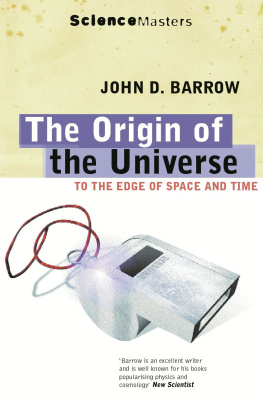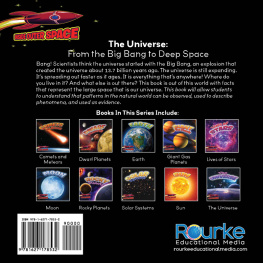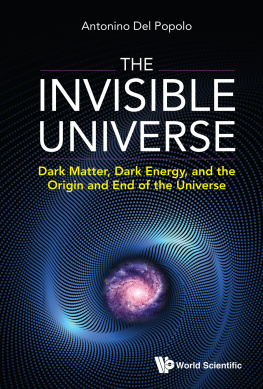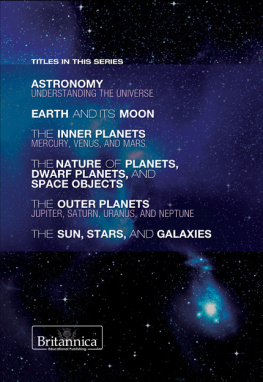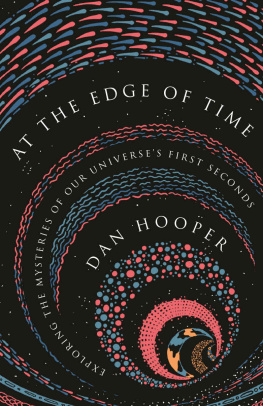To Dennis and Bill,
Cosmologists, gentlemen, and teachers,
To whom many owe much
The Origin of the Universe
TO THE EDGE OF SPACE AND TIME
John D. Barrow


Beautiful are the things we see
More beautiful those we understand
Much the most beautiful those we do not comprehend.
Niels Steensen (Steno) 16381686
CONTENTS


W e are living in the universes prime, long after most of the exciting things have happened. Gaze into the sky on a starry night and you will see a few thousand stars, most straddling the darkness in a great swath we call the Milky Way. This is all the ancients knew of the universe. Gradually, as telescopes of greater and greater size and resolution have been developed, a universe of unimagined vastness has swum into view. A multitude of stars gathered into the islands of light we call galaxies, and all around the galaxies is a cool sea of microwavesthe echo of the big bang some fifteen billion years ago. Time, space, and matter appear to have their origins in an explosive event from which the present-day universe has emerged in a state of overall expansion, slowly cooling and continuously rarifying.
In the beginning, the universe was an inferno of radiation, too hot for any atoms to survive. In the first few minutes, it cooled enough for the nuclei of the lightest elements to form. Only millions of years later would the cosmos be cool enough for whole atoms to appear, followed soon by simple molecules, and after billions of years by the complex sequence of events that saw the condensation of material into stars and galaxies. Then, with the appearance of stable planetary environments, the complicated products of biochemistry were nurtured, by processes we still do not understand. But how and why did this elaborate sequence of events begin? What do modern cosmologists have to tell us about the beginning of the universe?
The various creation stories of ancient times were not scientific theories in any modern sense. They did not attempt to reveal anything new about the structure of the world; they aimed simply to remove the specter of the unknown from human imaginings. By defining their place within the hierarchy of creation, the ancients could relate the world to themselves and avoid the terrible consideration of the unknown or the unknowable. Modern scientific accounts need to achieve much more than this. They must be deep enough to tell us more about the universe than what we have put into them. And they must be broad enough to make predictions, as a check on their credentials to explain the things we already know about the world. They should bring coherence and unity to collections of disconnected facts.
The methods employed by modern cosmologists are simple, but not necessarily obvious to the outsider. They begin by assuming that the laws governing the workings of the world locally, here on Earth, apply throughout the universe until one is forced to conclude otherwise. Typically one finds that there are some places in the universe, especially in the past, where extreme conditions of density and temperature are encountered which are outside our direct experience on Earth. Sometimes our theories are expected to continue to work in these domainsand, indeed, do. But on other occasions we are working with approximations to the true laws of natureapproximations that possess known limits of applicability. When we reach those limits, we must try to establish better approximations to cover the unusual new conditions we have found. Many theories make predictions that we cannot test by observation. Indeed, it is those sorts of predictions that often dictate the types of observatory or satellite to be developed in the future.
Cosmologists often talk about constructing cosmological models. By this they mean producing simplified mathematical descriptions of the structure and past history of the universe which capture its principal features. Just as a model airplane reproduces some, but not all, of the features of a real airplane, so a model universe cannot hope to incorporate every detail of the universes structure. Our cosmological models are very rough and ready. They begin by treating the universe as if it were a completely uniform sea of material. The clumping of material into stars and galaxies is ignored. Only if one is investigating more specific issues, like the origins of stars and galaxies, are the deviations from perfect uniformity considered. This strategy works remarkably well. One of the most striking features of our universe is the way in which the visible part of it is so well described by this simple idealization of it as a uniform distribution of material.
Another important feature of our cosmological models is that they involve propertieslike density or temperaturewhose numerical values can be found only by observation, and only particular combinations of observed values for a number of these quantities will be allowed by the model. In this way compatibility between the model and the real universe can be checked.
Our exploration of the universe has taken off in different directions. Besides satellites, spacecraft, and telescopes, we have employed microscopes, atom-smashers and accelerators, computers and human thinking to enlarge our understanding of the entire cosmic environment. Besides the world of outer spacethe stars, galaxies, and great cosmic structureswe have come to appreciate the labyrinthine subtlety within the depths of inner space. There we find the subatomic world of the nucleus and its parts: the basic building blocks of matterso few in number, so simple in structure, but in combination capable of being organized into the vast panoply of complexity we see around us and of which we are a peculiar part.
These two frontiers of our understandingthe small world of the elementary parts of matter and the astronomical world of the stars and galaxieshave come together in unexpected ways in recent times. Where once they were the domains of different groups of scientists attempting to answer quite different questions by separate means, now their interests and methods are intimately entwined. The secret of how galaxies came into being may well be fathomed by the study of the most elementary particles of matter in particle detectors buried deep underground; the identity of those elementary particles may be revealed by observations of distant starlight. And as we try to reconstruct the history of the universe, searching for the fossil remnants of its youth and adolescence, we find that by the coming together of the largest and the smallest aspects of the physical world our appreciation of the unity of the universe becomes more impressive and complete.
This little book aims to provide a short account of the Beginning for beginners. What evidence do we have about the early history of the universe? What are the latest theories about how the universe could have begun? Can we test them by observation, and how does our own existence relate to them? These are some of the questions that will arise on our journey to the origins of time. I shall present some of the latest speculative theories about the nature of time, the inflationary universe, and wormholes, and along the way explain the significance of the COBE satellite observations that were greeted with such euphoria in the spring of 1992.
Next page
